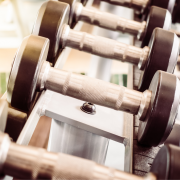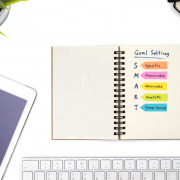The Great Weight Debate
Our group fitness schedule at FFC features a wide variety of classes, including yoga, dance, indoor cycling and a number of strength training classes. Depending on the class type, these strength training classes may utilize bodyweight movements or the instructor may call for the use of dumbbells.
Most of the questions I receive from students in group fitness classes are about training with weights: Which dumbbells should I grab? Will lifting weights in class make me bulky? How should I schedule my weight training? I answer these questions and give my recommendations below.
What Size Weights Should I Use?
One of the most commonly asked questions when it comes to group fitness classes is what size weights should I use? With all of the different class formats we offer at FFC, I can understand why this can be so confusing.
I like to classify muscle conditioning classes in two ways; muscular strength and muscular endurance. Keep in mind, muscular conditioning classes do crossover between these two training systems. When a student asks me what size dumbbells should they should use, my answer is pretty simple: grab something you believe to be light and something you believe to be heavy.
Related: Are you performing these exercises correctly in your group fitness classes?
Here is where it gets tricky. A heavy weight to one person could be considered light for another, so it becomes a very personal choice. It can also change from day to day or week to week depending on what other forms of exercise people are doing. For example, if it is a Saturday morning and you’re headed to take Chisel and you have been training hard all week, you may need to go with a lower weight to accommodate how you are feeling.
Our signature class Critical Mass is considered a strength training class, meaning slower tempo, full range of movement, lower repetition range and heavier weights to build strength. As a student, your choice in weights would be determined by how well you can meet the demands of the class where the work is challenging and you feel successful. Conversely, our signature format Formula 94 is classified as a muscular endurance workout; fast moving, high repetition, non-stop high intensity. The size of dumbbells you choose need to be lighter to be able accommodate this style of training. My recommendation here is 2.5 – 5 lbs.

Will Training With Heavy Weights Make Me Bulky?
The truth here is that in order to build real lean muscle your nutritional requirements need to support such growth. Most people that use the word bulk are not considering the amount of body fat that still exists, giving the look of muscular bulk when in fact their body fat percentages are too high. With proper nutrition, training heavy will provide a dense musculature giving a lean sculpted physique.
If I Stop Weight Training, Will My Muscles Turn In To Fat?
The reality here is muscle and fat are two completely different entities. An apple will never become a bagel no matter what happens. Muscle, on the other hand, will increase the amount of fat burned during a training session. If you want to burn fat as fuel, trade out a cardio session for a strength workout.
Related: How To Choose The Best Classes At The Gym
Is The Best Way To See Results To Train One Body Part Per Day?
Finding classes that incorporate compound exercises which work more than one body part at a time will deliver a more effective workout within a shorter amount of time. This is where taking group fitness classes can be so valuable! Most of our weighted class formats at FFC contain different elements of cardiovascular training, muscle conditioning and core specific drills giving you a comprehensive total body workout all in 45 minutes. Check out our signature classes LOADED, Chisel, Total Body Blast, The Formula and #312 for a full body, fun workout.
What Exercises Are Most Beneficial For Older Adults?
Any good trainer or group fitness instructor knows that we should not classify people’s optimal exercise program based on their age; we need to classify people’s training protocol based on their ability. There it is, I said it! Just because we have reached a certain age does not mean we cannot or should not run incline sprints on a treadmill or take a kettlebell class on the turf. Whether you are a beginner or a competitive fit athlete, your fitness game plan will ebb and flow. Our goal always is to provide safe, effective, results driven workouts that keep you engaged, healthy, with a continued path toward success and well being.

Post written by FFC Group Fitness Director Lois Miller.



